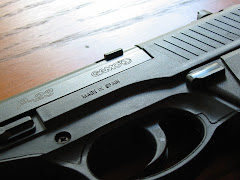In reviewing a large number of posts regarding the modification of airguns on the Pyramid Air Blog the discussion focused on those made to air rifles by Airforce Airguns of Fortworth, Texas (USA). There was particular emphasis placed on "mods" promoted on a popular internet forum, which raised a number of interesting questions.
These questions are:
1. Are modifications to airguns okay or do they result in premature breakdowns and potentially dangerous conditions?
2. Are airgun modifications necessary/required for satisfactory performance?
3. Are modifications a form of personalization? Or are they customized to better serve a particular purpose (example: Dennis Quackenbush's "Shot" pistols originally created to dispatch problematic carpenter bees.)
The Pyramid Blog was initiated, in part, regarding claims of reduced longevity and durability when certain popular modifications were utilized (ex. heavier hammer.) Counterpoints were foisted that the "mods" were outside of the initial design parameters and over-stressed certain components to the point of failure. A response from others argued back with anecdotal "evidence" to the contrary, along with allegations of misled buyers who merely trying to obtain the performance levels they'd been promised by the manufacturer.
In my recollection, at least one respondent compared the situation to an recent encounter with the U.S. firearms industry. At one time it was said that at least one major (U.S.) handgun manufacturer's flagship product necesitated an immediate trip to a competent pistolsmith so that it could fire reliably and and with acceptable accuracy. A great beginning for a gun?
At the same time, as many of the respondents noted that customization and "mods" have a long standing tradition in the history of American Shooters. Regardless of whether you are talking about ivory (or stag handles) on a six shooter, or a custom tigger job on a Colt Gold Cup (.45 Cal. firearm) Americans have sought to individualize or improve those items that are useful and reliable. Like the tuning or modification of cars, this benefit may be real or percieved. The trend is undeniable.
Of course part of the argument breaks down into "am I making it usable" or "am I making it better". Example: If you purchased a new car that was advertised as a reliable and economical commuter vehicle but in fact you had to have it serviced multiple times at great expense in order to get it to work for three days in a row, then you obviously have a complaint about the manufacturers representations.
Does such a thing occur with some air gun manufactuers? (In my opinion the jury is still out on this.)
To my way of thinking, if I purchase an item for personal reasons, the desire to personalize and modify it is reasonable. Cell phone covers, skins, wall papers and wheels have us screaming our uniqueness and individuality. In the case of air guns, I do however want a safe and reasonably durable device that serves it's intended purpose. A certain degree of pride of ownership and potential for financial gain are an assett or at least benefit for many of the rising number of air gun shooters and collectors in the US.
Case in Point. The Crossman 1377, 2250, 2260 and model 600 pellet pistols.
MORE to follow tomorrow (or there soon after.) LS...
Thursday, April 26, 2007
Subscribe to:
Post Comments (Atom)


No comments:
Post a Comment